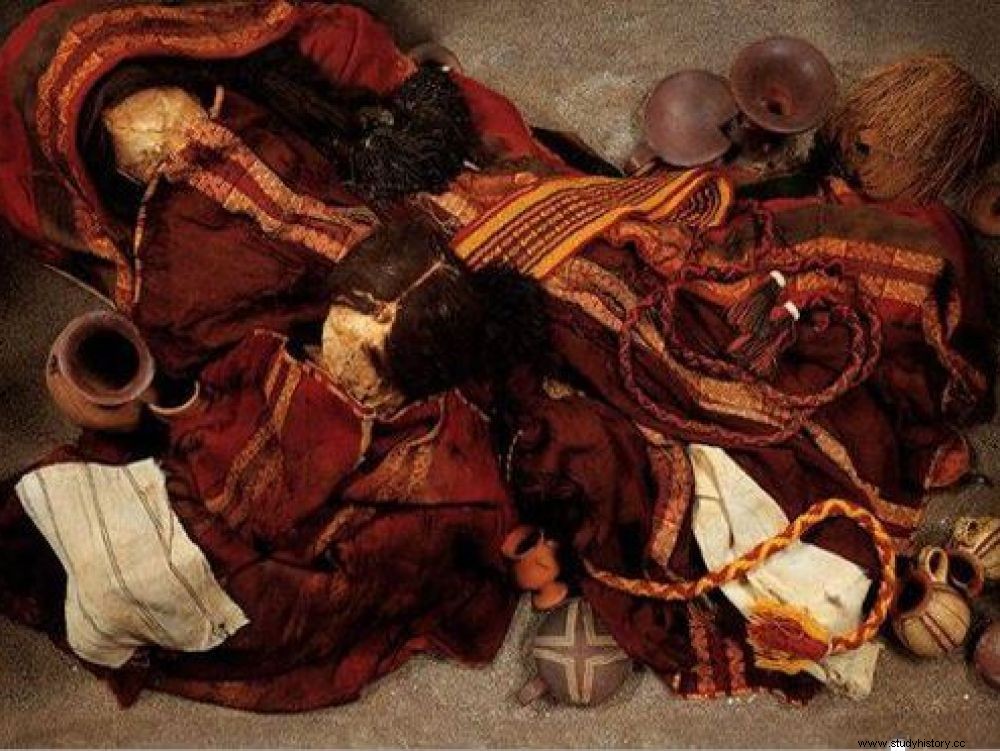The recent identification of cinnabar, a sulphide of mercury, on Inca textiles, has made specialists wonder about the toxicity of this product and the health impact it could have had.

Inca mummy and textiles from Cerro Esmeralda, Iquique region, Chile.
SACRIFIED . Since the 1970s, the Andes have delivered the buried bodies of many Inca children. Victims of ritual sacrifices, called capacocha , they were buried in the midst of priceless offerings, adorned with finery:wrapped in clothes or mantos finely woven, in llama, guanaco or vicuña wool. But today information disclosed by the journal Archaeometry , covered by Live Science , reveals the presence of cinnabar (HgS, mercury sulphide) - a substance described as toxic - on some of the fabrics worn by two of these mummies. A 9-year-old girl and an 18-year-old young woman found by chance in 1976 during the construction of a road in northern Chile. Immolated between 1399 and 1475 AD, their remains lay curled up at the bottom of a pit in Cerro Esmeralda, in the region of Iquique, a territory then located within the limits of the Inca empire of Tawantinsuyo .
In addition to this discovery made for the first time in this part of the Andes, the authors question whether or not these ancient cultures may have been aware of the potential danger of cinnabar (86% mercury and 14% sulfur), knowing the alterations that mercury causes on the nervous system and muscles, in case of extreme exposure or inhalation. A more relevant question than the suggestion of its possible use to deter grave robbers, by means of "poisoned" textiles!
Example of a Mayan jade mask covered with cinnabar. © Proyecto Arqueologico Waka /Ministry of Culture and Sports of Guatemala
A beautiful scarlet hue, the use of cinnabar among the Incas - as well as in all other great American and Mesoamerican civilizations, where it is the most sacred pigment - was always associated with the elite and prestigious contexts. It was most often used in the form of powder dispersed on the body of the deceased, or even idols. In the Mayan world, for example, it was not uncommon to find jade masks covered with cinnabar, as much as among the Incas, gold adornments coated with the precious pigment, a metaphor for blood, the vital substance.
For researchers from the University of Tarapaca (Antofagasta) behind the study, the Incas knew the harmfulness of cinnabar. A theme to which (coincidence of the calendar?) also returns to a publication of the Journal of Archaeological Science*. This specialized magazine evokes, for its part, the exaggeration of the negative effects of its use on health. They should not be confused, argue the signatories, with mercury vapor, or mercury metal, which is very dangerous. They recall that cinnabar, for 2000 years, has also been an important component of traditional Indian Ayurvedic medicines. Or that this ingredient is identified in about forty recipes from the Chinese pharmacopoeia. "Modern concerns about mercury toxicity cannot be conflated with the pre-Hispanic ritual use of cinnabar" , say the anthropologists of the universities of Yale and Chicago, Richard L. Burger and Jerrokd B. Leikin. As for the mantos Incas and their traces of this mineral, Christophe Moulherat, archaeologist, specialist in ancient textiles at the Quai Branly museum in Paris, has just discovered some in Peru, on the Pachacamac site:"Cinnabar was used as a tinctorial pigment for symbolic use" . And probably prepared with a binder. Elements far from any curse of the mummy.
Find out more: "Cinnabar use in Prehispanic Peru and its possible health consequences », Journal of Archaeological Science, by Richard L. Burger and Jerrokd B. Leikin.

